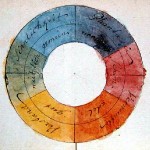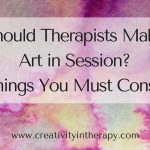Art therapy uses art-making as part of the healing and psychotherapy process. The American Art Therapy Association offers the following definition:
Art therapy is the therapeutic use of art making, within a professional relationship, by people who experience illness, trauma, or challenges in living, and by people who seek personal development. Through creating art and reflecting on the art products and processes, people can increase awareness of self and others cope with symptoms, stress, and traumatic experiences; enhance cognitive abilities; and enjoy the life-affirming pleasures of making art.
Within the art therapy community there is some variation in how therapists use art with clients. Some art therapists focus primarily on the making of art as therapeutic in and of itself, or “art as therapy.” Others may incorporate art-making into psychotherapy as a means of communication, exploration, and experience for the client. Art-making may also be incorporated into the work of therapists who do not consider themselves to be art therapists, such as using drawing or sculpting in play therapy. In this blog, I will consider art therapy to encompass any of these approaches as each has value.
 Art therapists utilize a variety of art media, including drawing, painting, sculpture, collage, and photography. Art therapy can be used to work with individuals, families, and groups of any age. Sometimes the art-making may be structured by giving the client a directive to explore a specific topic in his/her art. In contrast, the open-studio approach provides a safe environment where clients can create whatever art they feel inspired to do. Art therapy can be used with a variety of clients and situations, including grief and loss, depression, stress and anxiety, trauma, children with acting out behavior or ADHD, chronic mental illness, substance abuse, eating disorders, and autism spectrum.
Art therapists utilize a variety of art media, including drawing, painting, sculpture, collage, and photography. Art therapy can be used to work with individuals, families, and groups of any age. Sometimes the art-making may be structured by giving the client a directive to explore a specific topic in his/her art. In contrast, the open-studio approach provides a safe environment where clients can create whatever art they feel inspired to do. Art therapy can be used with a variety of clients and situations, including grief and loss, depression, stress and anxiety, trauma, children with acting out behavior or ADHD, chronic mental illness, substance abuse, eating disorders, and autism spectrum.
In my own work, I have found art to be a powerful tool for helping people to express themselves in a way that words may not have allowed. As a means of communication, sometimes the images we create allow us to express the things we do not know how to say or are too scared to say out loud. But oftentimes it is the process of creating that is the most important, helping us to helping us to explore and discover something new about ourselves, or access a hidden aspect of ourselves.
To learn more about art therapy, check out these links:
- “What is Art Therapy? by The International Art Therapy Organization
- “What is Art Therapy?” from About.com
- The Healing Arts–Psychology Today blog by art therapist Cathy Malchiodi
Some organizations related to art therapy and providing information:
- The American Art Therapy Association
- The International Art Therapy Organization
- Art Therapy Alliance
- Art Therapy Credentials Board
- Art Therapy Without Borders
Never miss a post! Click here to sign up for the email newsletter.
Carolyn Mehlomakulu, LMFT, ATR is a psychotherapist in Austin, Texas who works with children, adolescents, and families. For more information about individual therapy, child counseling, family therapy, and art therapy services, please visit www.therapywithcarolyn.com.
This blog is not intended to diagnose or treat any mental health conditions. All directives, interventions, and ideas should be used by qualified individuals within the appropriate bounds of their education, training, and scope of practice. Information presented in this blog does not replace professional training in mental health, psychotherapy, counseling, art therapy, or play therapy. Although anyone can have a healing experience with art, art therapy requires the direction of a trained art therapist.
This blog includes affiliate links (see full disclosure here). If you’d like to help support the blog without any extra cost to you, please click through on Amazon links and shop as you normally would. Your support is greatly appreciated!





This is a very useful post for me! Art Therapy is good for seek personal development .